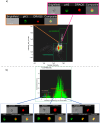A multi-biomarker micronucleus assay using imaging flow cytometry
- PMID: 38995349
- PMCID: PMC11324684
- DOI: 10.1007/s00204-024-03801-7
A multi-biomarker micronucleus assay using imaging flow cytometry
Abstract
Genetic toxicity testing assesses the potential of compounds to cause DNA damage. There are many genetic toxicology screening assays designed to assess the DNA damaging potential of chemicals in early drug development aiding the identification of promising drugs that have low-risk potential for causing genetic damage contributing to cancer risk in humans. Despite this, in vitro tests generate a high number of misleading positives, the consequences of which can lead to unnecessary animal testing and/or the abandonment of promising drug candidates. Understanding chemical Mode of Action (MoA) is vital to identifying the true genotoxic potential of substances and, therefore, the risk translation into the clinic. Here we demonstrate a simple, robust protocol for staining fixed, human-lymphoblast p53 proficient TK6 cells with antibodies against ɣH2AX, p53 and pH3S28 along with DRAQ5™ DNA staining that enables analysis of un-lysed cells via microscopy approaches such as imaging flow cytometry. Here, we used the Cytek® Amnis® ImageStream®X Mk II which provides a high-throughput acquisition platform with the sensitivity of flow cytometry and spatial morphological information associated with microscopy. Using the ImageStream manufacturer's software (IDEAS® 6.2), a masking strategy was developed to automatically detect and quantify micronucleus events (MN) and characterise biomarker populations. The gating strategy developed enables the generation of a template capable of automatically batch processing data files quantifying cell-cycle, MN, ɣH2AX, p53 and pH3 populations simultaneously. In this way, we demonstrate how a multiplex system enables DNA damage assessment alongside MN identification using un-lysed cells on the imaging flow cytometry platform. As a proof-of-concept, we use the tool chemicals carbendazim and methyl methanesulphonate (MMS) to demonstrate the assay's ability to correctly identify clastogenic or aneugenic MoAs using the biomarker profiles established.
Keywords: Biomarker; DNA damage; ImageStream; Micronucleus; MoA; NAM.
© 2024. The Author(s).
Conflict of interest statement
None.
Figures





References
-
- Allemang A, Thacker R, DeMarco RA, Rodrigues MA, Pfuhler S (2021) The 3D reconstructed skin micronucleus assay using imaging flow cytometry and deep learning: a proof-of-principle investigation. Mutat Res Genet Toxicol Environ Mutagen 865:503314. 10.1016/j.mrgentox.2021.503314 10.1016/j.mrgentox.2021.503314 - DOI - PubMed
-
- Branda RF, O'Neill JP, Brooks EM, Trombley LM, Nicklas JA (2001) The effect of folate deficiency on the cytotoxic and mutagenic responses to ethyl methanesulfonate in human lymphoblastoid cell lines that differ in p53 status. Mutat Res 473(1):51–71. 10.1016/s0027-5107(00)00138-x - PubMed
MeSH terms
Substances
Grants and funding
LinkOut - more resources
Full Text Sources
Research Materials
Miscellaneous

